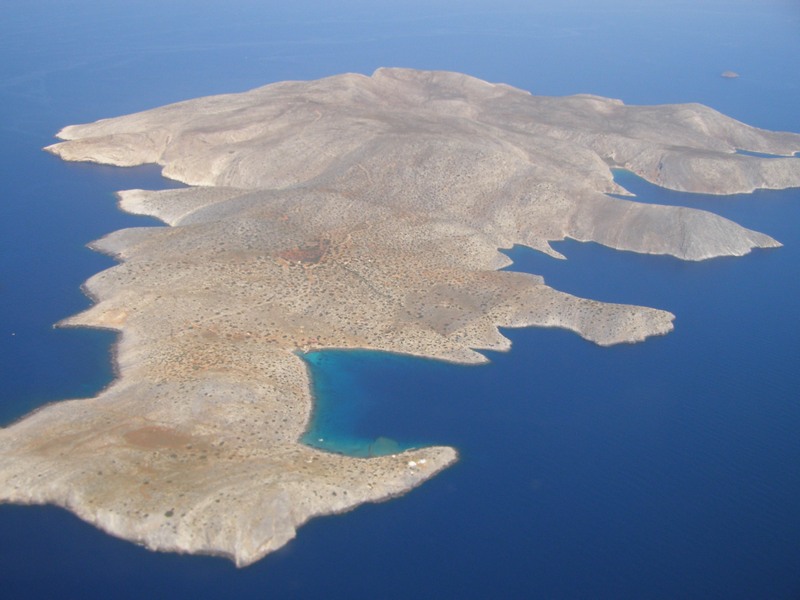 |
| Photo of the island from plane |
Crete has several islets around who accompany as good friends for centuries. Some of these have experienced human presence and intervention "climbing" the ladder of tourism development. But there are several uninhabited resisting yet. It is welcoming to man, as he has learned to set the terms of their daily survival.
One
of these is the island of Dia, 6 nautical miles northeast of
Heraklion, just because that is deserted by humans, has a very
important ecosystem and a special biodiversity, so it is a protected area
of the network Natura. Many protected native species,
the snail Albinaria retusa, the lizard "Podarcis erhardii schiebeli", the
wild rabbit "Oryctolagus cuniculus cnossius", the "Mavropetrίtis" falcon- a kind that its
population monitored by ornithologists-but plants like "chasmophyte
Carlina diae" are some of the samples from the rich biodiversity of the
island. Now, how the island can be a controlled hunting area, this only authorities can explain it!
For the origin of the name of the island there are several opinions. Indicates that the name Zeus (Zeus is Dias in simple Greek) is related to Minos' daughter Ariadne, who had been left on the island behind by Theseus, when he returned to Athens. Others, relate to Dionysades islands, located northeast of Crete. A third option is that the name of the island have been taken by the nickname of goddess Aphrodite: Dia.
 |
| Stones and shrubs: the main physical features of the island |
Geomorphological point of Dia is 5km long, 3 km wide and size of 12 square kilometers, oriented from west to east. On
the south side of the island are sheltered four sheltered bays : The St George's Bay,
where there is a unique harbor and beach of the island, the Bay of Capers, the "Panayiά's Bay" (means thw Holy Mother's bay) and the Bay of Wild Olivetree. To the east is the Bay of Artichokes. The maximum height is 220 feet and is generally compatible with the unique landscape of rocks and bushes. There are areas with wild cliffs reaching 60 meters. North of Dia Two small islands full of gulls, "Paximadi" and "Petalidi".
 |
| Human intervention ... fortunately small |
The
legend behind the story says that it was created by Zeus: Once, Zeus
ruled the world from his throne in Olympus, looked toward the birthplace
of Crete, and then surprised he saw the Cretans to hunt with
bows and spears, wiping his favorite wild goats (Kri Kri), children of
Amalthea nourished him with her milk when hiding from his father Saturn
in "Idέon Άndron" cave . He got angry so much that he decided to kill all Cretans. Immediately threw a thunderbolt at sea and a huge monster emerged with the purpose of destroying the Cretans. However, the other gods tried to make him change his mind, but in vain. Then
Neptune, who from his kingdom, the sea, the beast came, he said to
Zeus: "Father and my King that can devastate the Curetes, so will repay
whatever good you have made? '. Curetes were Cretans who banged loudly of their shields to not his father Saturn hear his son crying and eat him. Zeus immediately changed his mind. Then she took two pieces of rusk and flew off Crete. So when did the monster to eat him with a thunderbolt petrified with the rusks. Thus was born the Dia both islands, Paximadi (paximadi in Greek means rusk) and Petalidi.
 |
| The colorful seabed of the island |
 |
| Flying fish by Dia |
The island's history is intense since the Minoan period, thanks to great for navigation position. It was the island that reminded mariners that the coasts and harbors of Crete was near. A fortified coastal Minoan settlement has been located near the Gulf of St George confirms the habitation of the island. On the surface, the end of the island have been identified and other traces of habitation, and we know that there was a small vineyard cultivation until 1937, made by anglers.
 |
| The Harbour |
The
years 1974-75, the great French oceanographer Jacques-Yves Cousteau,
who tried to find the lost city of Atlantis lies between Crete and
Santorini, with the help of a submersible discovered 7 ancient shipwrecks
in Dia , with many amphorae and other archaeological finds dredged. The next year he discovered the Cyclopean Walls, as named by the experts. It is squared and rectangular rocks that made up an artificial breakwater. He Cousteau believed it was the largest and most important harbor of Knossos, which plummeted from the eruption of Santorini. Today,
it is believed that the jetty is even older, however, new
archaeological research to prove his paternity has not yet taken place.
Achilles Tagaris in Illustrated History (Vol 143, 1980) states that the island was overgrown with lush forests and crystal springs. Forests destroyed for shipbuilding, the sources dried up, while the eruption of Santorini in 1450 BC ended at any sign of life of Zeus, as the huge tidal waves swept away everything in their path.
 |
| Cousteau with M. Voutsala and his research team. |
In
the sea area between Heraklion and Dia discovered by Cousteau and
Herakleion Manolis Voutsala (Bloblos) and the wreck of the French ship
of the 17th century "La Therese". The ship was part of the
French aid was sent to Candia during the siege by the Ottomans and was
the only ship that sank on June 24, 1669. Was yponafarchida fleet and was sunk by the explosion of gunpowder.
 |
| The church of St. George |
On the island, there are no facilities except a tavern near the harbor of the island on the Bay of St. George. There is the beautiful church of St. George, where you can agnantefsete Crete. Access to the island by boats that run day trips. Source: lexifilia.blogspot.gr








Δεν υπάρχουν σχόλια:
Δημοσίευση σχολίου